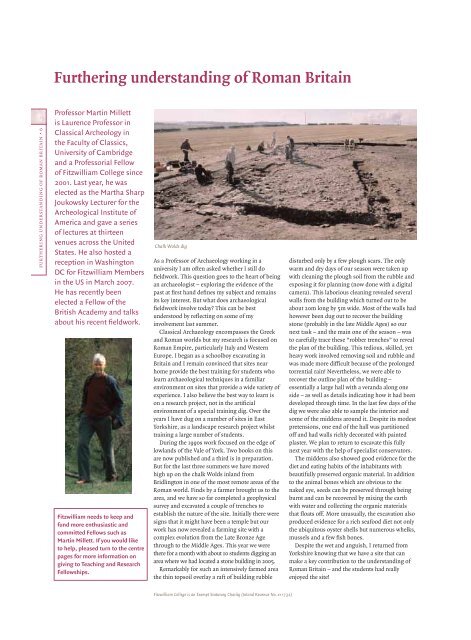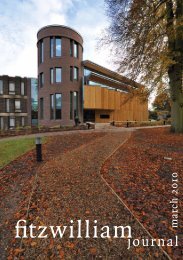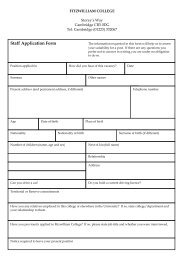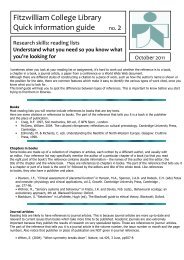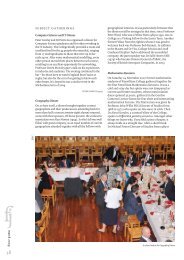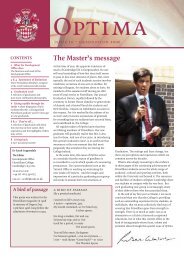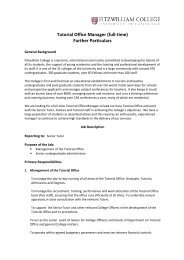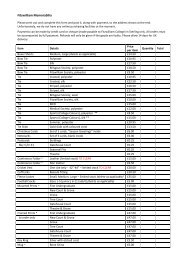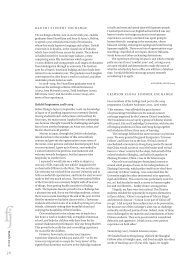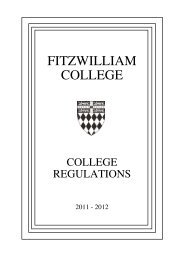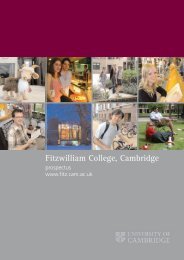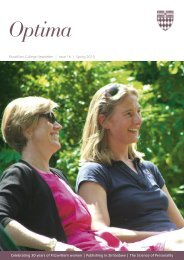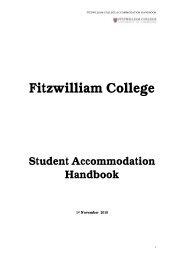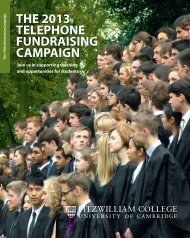Optima 12 - Fitzwilliam College - University of Cambridge
Optima 12 - Fitzwilliam College - University of Cambridge
Optima 12 - Fitzwilliam College - University of Cambridge
Create successful ePaper yourself
Turn your PDF publications into a flip-book with our unique Google optimized e-Paper software.
furthering understanding <strong>of</strong> roman britain • 6<br />
Furthering understanding <strong>of</strong> Roman Britain<br />
Pr<strong>of</strong>essor Martin Millett<br />
is Laurence Pr<strong>of</strong>essor in<br />
Classical Archeology in<br />
the Faculty <strong>of</strong> Classics,<br />
<strong>University</strong> <strong>of</strong> <strong>Cambridge</strong><br />
and a Pr<strong>of</strong>essorial Fellow<br />
<strong>of</strong> <strong>Fitzwilliam</strong> <strong>College</strong> since<br />
2001. Last year, he was<br />
elected as the Martha Sharp<br />
Joukowsky Lecturer for the<br />
Archeological Institute <strong>of</strong><br />
America and gave a series<br />
<strong>of</strong> lectures at thirteen<br />
venues across the United<br />
States. He also hosted a<br />
reception in Washington<br />
DC for <strong>Fitzwilliam</strong> Members<br />
in the US in March 2007.<br />
He has recently been<br />
elected a Fellow <strong>of</strong> the<br />
British Academy and talks<br />
about his recent fieldwork.<br />
<strong>Fitzwilliam</strong> needs to keep and<br />
fund more enthusiastic and<br />
committed Fellows such as<br />
Martin Millett. If you would like<br />
to help, pleased turn to the centre<br />
pages for more information on<br />
giving to Teaching and Research<br />
Fellowships.<br />
Chalk Wolds dig<br />
As a Pr<strong>of</strong>essor <strong>of</strong> Archaeology working in a<br />
university I am <strong>of</strong>ten asked whether I still do<br />
fieldwork. This question goes to the heart <strong>of</strong> being<br />
an archaeologist – exploring the evidence <strong>of</strong> the<br />
past at first hand defines my subject and remains<br />
its key interest. But what does archaeological<br />
fieldwork involve today? This can be best<br />
understood by reflecting on some <strong>of</strong> my<br />
involvement last summer.<br />
Classical Archaeology encompasses the Greek<br />
and Roman worlds but my research is focused on<br />
Roman Empire, particularly Italy and Western<br />
Europe. I began as a schoolboy excavating in<br />
Britain and I remain convinced that sites near<br />
home provide the best training for students who<br />
learn archaeological techniques in a familiar<br />
environment on sites that provide a wide variety <strong>of</strong><br />
experience. I also believe the best way to learn is<br />
on a research project, not in the artificial<br />
environment <strong>of</strong> a special training dig. Over the<br />
years I have dug on a number <strong>of</strong> sites in East<br />
Yorkshire, as a landscape research project whilst<br />
training a large number <strong>of</strong> students.<br />
During the 1990s work focused on the edge <strong>of</strong><br />
lowlands <strong>of</strong> the Vale <strong>of</strong> York. Two books on this<br />
are now published and a third is in preparation.<br />
But for the last three summers we have moved<br />
high up on the chalk Wolds inland from<br />
Bridlington in one <strong>of</strong> the most remote areas <strong>of</strong> the<br />
Roman world. Finds by a farmer brought us to the<br />
area, and we have so far completed a geophysical<br />
survey and excavated a couple <strong>of</strong> trenches to<br />
establish the nature <strong>of</strong> the site. Initially there were<br />
signs that it might have been a temple but our<br />
work has now revealed a farming site with a<br />
complex evolution from the Late Bronze Age<br />
through to the Middle Ages. This year we were<br />
there for a month with about 10 students digging an<br />
area where we had located a stone building in 2005.<br />
Remarkably for such an intensively farmed area<br />
the thin topsoil overlay a raft <strong>of</strong> building rubble<br />
<strong>Fitzwilliam</strong> <strong>College</strong> is an Exempt Statutory Charity (Inland Revenue No. x11732)<br />
disturbed only by a few plough scars. The only<br />
warm and dry days <strong>of</strong> our season were taken up<br />
with cleaning the plough soil from the rubble and<br />
exposing it for planning (now done with a digital<br />
camera). This laborious cleaning revealed several<br />
walls from the building which turned out to be<br />
about 20m long by 5m wide. Most <strong>of</strong> the walls had<br />
however been dug out to recover the building<br />
stone (probably in the late Middle Ages) so our<br />
next task – and the main one <strong>of</strong> the season – was<br />
to carefully trace these “robber trenches” to reveal<br />
the plan <strong>of</strong> the building. This tedious, skilled, yet<br />
heavy work involved removing soil and rubble and<br />
was made more difficult because <strong>of</strong> the prolonged<br />
torrential rain! Nevertheless, we were able to<br />
recover the outline plan <strong>of</strong> the building –<br />
essentially a large hall with a veranda along one<br />
side – as well as details indicating how it had been<br />
developed through time. In the last few days <strong>of</strong> the<br />
dig we were also able to sample the interior and<br />
some <strong>of</strong> the middens around it. Despite its modest<br />
pretensions, one end <strong>of</strong> the hall was partitioned<br />
<strong>of</strong>f and had walls richly decorated with painted<br />
plaster. We plan to return to excavate this fully<br />
next year with the help <strong>of</strong> specialist conservators.<br />
The middens also showed good evidence for the<br />
diet and eating habits <strong>of</strong> the inhabitants with<br />
beautifully preserved organic material. In addition<br />
to the animal bones which are obvious to the<br />
naked eye, seeds can be preserved through being<br />
burnt and can be recovered by mixing the earth<br />
with water and collecting the organic materials<br />
that floats <strong>of</strong>f. More unusually, the excavation also<br />
produced evidence for a rich seafood diet not only<br />
the ubiquitous oyster shells but numerous whelks,<br />
mussels and a few fish bones.<br />
Despite the wet and anguish, I returned from<br />
Yorkshire knowing that we have a site that can<br />
make a key contribution to the understanding <strong>of</strong><br />
Roman Britain – and the students had really<br />
enjoyed the site!


